Although the future looked very uncertain because of Covid a year ago, we still went ahead to book at cruise on the Danube that would start in Regensburg and end in Bucharest. Fortunately, the time has come and restrictions have been relaxed such that it could take place.
Birmingham airport dished up very long and slow security queues that took as long as the flight time! But, plane was on time and we were soon on the way to join our ship, the Emerald Destiny, under a dull sky with some rain and a chilly wind.
It's a classic river cruise vessel, 135m long, but with superstructure that can be lowered, including the wheelhouse, to go under the lowest bridges on the network.
The Route
Our walking tour of Regensburg was disrupted, making our guide very exasperated at the "idiots running" and wondering why she was doing it today, by a marathon around the streets! It meant that we could not follow her preferred route and she had quite a heated exchange with a marshal who forbid her to cross the runners! But, it was well supported by cheering crowds and the atmosphere was other otherwise jolly as we wandered the streets with her. We did manage to see some interesting old buildings and get a feel for this city of medieval origins.
Built in 11 years, restored recently in 9!
Overnight, we sailed to Passau, on the confluence of the Danube, Inn and Ilz rivers, a collision of waterways of different sizes, depths and sedimentary colours. These differences, mainly the Danube and Inn, show up quite distinctly where they join together at the tip of this old town.
Danube from the left, Inn from the right
Because of the confluence, the town is prone to dramatic flooding and several watermarks up of over 12m were seen marked on buildings. But it seems that the architects and residents are well prepared and used to these events.
Arches between buildings for stability during floods
St Stephens' Cathedral organ with >17,700 pipes!
Jean peeks out
Locks and low bridges were a regular feature, one where I felt the need to duck!
I was very impressed with the piloting skills of our Captain, dead straight with millimetres to spare and parallel along all 135m to the lock walls, plus turning with side thrusters on one occasion with just metres fore and aft for clearance.
Remote control pods helped, one either side!
Next morning, we were in Melk, a small town but with an impressive Benedictine Abbey above it. Before the Habsburg Dynasty it was the seat of power for the Babenburg Dynasty until 1246, so could be regarded as an early capital of Austria. It has variously been a Monastery and Boarding School and still houses a large mixed school for the local area together with an impressive library with many bound manuscripts hand written by monks over many years. No pictures were allowed inside, allegedly to ensure the sale of postcards in the shop!
1718
Melk viewed from the Abbey
Coffee, and time to ponder!
Abbey above the main street
Then it was a short sail through the very pretty wine growing Wachau valley to an even smaller town, Durnstein, merely one street but famed for its apricot-based liqueurs, chutneys and many other things.
(The) Main Street
Next morning, we woke up docked in Vienna, where we were taken on a bus and walking tour of this beautiful city. It was so pleasing to see fine old architecture maintained in the centre, protected by city planners from the usual glass box additions of recent years elsewhere. There is so much to see and enjoy that a separate visit would be justified. The walking tour was enriched by our guide Veronika who had a great sense of humour and cynicism for some of the history of her city.
Steps to a Munck exhibition
Spanish Riding School horses step out as we passed by
St Stephen's Cathedral
Obligatory coffee and apricot strudel, of course!
Next it was onward to Bratislava, Slovakia, in the night. Once again we were led by a guide with a great sense of humour, Katarina.
Soviet era eyesore
Soviet era monument
Hans Christian Andersen
(less his Ugly Duckling, pinched from the base)
Holocaust Memorial
The centre is pedestrian only and was easy walking from our mooring. Most of the buildings are rather classic and grand and very few are of the Soviet era. It is also kept very clean. Several statues brought amusement.
A Napoleonic soldier with his backside facing the French Embassy!
A Man at Work
head and shoulders out of a manhole
but actually depicting the City's upskirt voyeur!
Katarina explained that the sign was actually put up as a warning. It is popular with young kids who sit on it, but is popular with dogs too, so the kids clean it unwittingly!
Coffee shop welcome
for a Bratislava Roll with Poppy Seeds & coffee
In the afternoon, I visited the village of Senkvice, about an hour from Bratislava, where a few of us were hosted by a local wine making family. It was all fairly small scale, with part of the vineyard in their garden, We sampled white, rose and red, the red being a local festival winner and it was all very pleasant. The small wine-making business was started by his parents, who still live in their part of the home and they do all their own processing and bottling, with the cellar under the house.
The wine press under cover and the wine awaits tasting!
We arose moored up to the Buda side of Budapest, on a warm to hot and dry day. We had last visited in 2009 but later in the year when it was quite cold, so this was a a contrast.
A bus with guide took us up the hill above Buda to visit the Castle District, King Matthias' Church and Fisherman's Bastion, with a superb overview of the Danube below and Pest on the other side.
King Matthias' Church
Fishermens' Bastion
King Matthias' Church
The magnificent Chain Bridge was closed for renovation and covered in scaffolding, so we were unable to enjoy this again.
Synagogue - 2nd largest in the World
Then it was on to Heroes' Square.
The rest of the day was just plain lazy back on board! Some passengers will leave us here and a few more will join for the Lower Danube segment to Bucharest. And the next day was nearly as lazy as most left, 8 of us remained on board and the newbies started arriving. We did, however, take a shuttle bus for a walkabout in downtown Pest, among the many grand buildings, a few eyesores that have been allowed among them, statues, fountains and enjoy a very fine ice cream.
Castle District on Buda, from Pest side
Funny little e-scooters, not seen before
Pest's oldest restaurant
Egg Nog & Yoghurt Chalices!
Can't you tell I've had enough shopping?
Before we left Budapest and start the Lower Danube section, we had to sail upriver before turning, to comply with regulations. Although this took an hour, it meant we came back to our mooring in the dark.
Then we were on our way to our last stop in Hungary before continuing on to Croatia, Serbia, Bulgaria and Romania. This was next morning at Kalosca and a short ride away was a working horse farm, Puszta, where a show of skills was laid on, as well as a glass of wine just after 10am and a local brandy after that! No girths on the saddles, so pretty much bareback. Chases & games with whips on horseback and a display of carriages were all impressive.
Armchair horse
The show's clown, bareback on the donkey
The most impressive skills, standing on the last pair of 10 horses!
Looking closer afterwards, there were no harnesses
binding each 4 together, just reins to control them
Repairs
Glass of brandy - why not in 29degC?
Tour & return to coach by carriage
Then it was onward downstream to a border crossing and a bit of delay while paperwork and our faces were checked by Police before allowing us to proceed to Croatia.
2 Police & Captain wait while face checks against passports are made by 2 others
As we sailed, we joined our Hungarian Captain and his Austrian Hotel Manager, Wolf, with 4 others for dinner at the Captain's Table.
Larger than life Wolf
By the morning, we had docked at Vukova in the eastern extreme of Croatia. From there we were taken by bus to Osijek where we visited a church, toured the remains of a fortress, then a very interesting and entertaining host in his home to be plied with drinks and some local foods, offered local produce and given a light hearted account of local fishing in the Danube, some twists on Croatian history and the theft of a Croatian grape to be rebadged as Zinfandel in California!
Much of this area still has evidence of the conflict remaining - bullet and shell holes still unfilled, buildings not rebuilt or repaired at all, along with some prevailing drabness from the communist era. It's an area that saw families torn apart because of the ethnic mix of Croats, Serbs joining opposite sides in a mini-civil war and there even remains Hungarian enclave to this day, such is the ethnic crossroads of this corner of Croatia. Some EU funded rebuilding is beginning to show.
Shell-damaged water tower in Vukova
Fortress
Bullet holes, unfilled


Local honey
Mask that allegedly scared off the Ottomans!
Framed for photo by our comedic host
Our stand-up host in full flow
Last of all, we were taken to a home for a hosted lunch and opportunity to taste local home-cooked food, home made brandy and find out directly about local life. The local hosting set-up is well organised and regulated, usually by families who also have a B&B business.
John from Canada, our hostess Nada, & John 's wife Linda
Pork & potato, salad
Coconut based cake to finish!
Including part of Andrew and Paula from UK
In the evening, we were treated to some Croatian music on board before we set sail for Belgrade, capital of Serbia. It sits around the confluence of the Danube and the Sava rivers.
Out city tour took us past some old and classic buildings, some damaged by bombing in the Balkan conflict, to the Kalemegdan Fortress, parts of which date from the 15th century. There, mostly in the moat, we saw the incongruous placement of tennis and basketball courts as well as a display of military hardware before proceeding inside and onto a hilltop overlooking the rivers.
Cannon ball and bullet damage, but not breach,
of the bronze and oak entrance door
Missile launchers and mortars
Including ancient tanks
Sava River to the left
Danube and the main confluence in the distance
A (naked) hero statue overlooks the Sava river,
can't remember who, or what he did
Josef Broz Tito's grave (1892-1980)
in The Flower House (museum)
Pictures of prominent leaders attending
including Margaret Thatcher
Only a few countries were not represented
at Tito's funeral.
Tito was masterful at diplomacy and also fund raising to rebuild Yugoslavia after WWII. Yugoslavia was not part of the eastern bloc and followed its own communist/socialist ideology, which afforded it independence and freedom of movement for its citizens. Our guide claimed that he had managed to obtain more than twice the funds in the whole of the Marshall Plan for rebuilding Europe, just for Yugoslavia, but I have been unable to verify this. There was no doubt he was a highly skilled and respected statesman internationally. No more countries have been represented at a leader's funeral, including Nelson Mandela's.
However, the history of the area, the formation and fragmentations of two Yugoslavia after each World War, is in itself complex enough and overall almost impossible to assimilate in just one visit! Sarajevo is famous for the shooting of the Archduke, but the first shot of WWI was fired in Belgrade.
Last of all, we visited St Sava Temple, still in the process of completion after some €43m of expenditure on marble and mosaic, an Orthodox church. It claims to be the largest Orthodox church in the World, although our guide ranked it second.








One door, featuring 8 of the 24 languages
Returning to our ship, we passed many more grand buildings, one of those bombed but not repaired, and a communist era concrete block of apartments.
Unrepaired bombing damage
Expedient and cheap, but not pretty!
I am not sure what I had expected of Belgrade, given all the troubled and complex history, but overall it was a pleasing experience to visit it. Its history requires some dedicated and intensive study to even get a reasonable overview of appreciation, but through this visit I learned a lot more about its part in Yugoslavian history under Tito and his unique leadership. I recalled the phrase "like trying to drink from a fire hose"!
Onward downstream, we stopped at Golubac just to disembark and take a short bus drive to an archaeological museum at Lepenski Vir. The remains had been excavated lower down the hillside, but had to be removed as the river was flooded behind a new dam in 1971, when the river rose some 12m and buried the site. The remains include 180 skeletons and date back to 8,000BC, so were very significant findings and had been meticulously catalogued and plotted before relocation.
Strong winds had required all sun deck furniture to be stowed flat
to avoid it going overboard on arrival at blustery Golubac!
Very wide and choppy lake area at Golubac
Smart Port Office
Off to tour again!
Lepenski Vir
The relocated remains
Settlement layout as it was
The base of one home
We re-joined downstream at Donji Milanovac, where we later had to wait patiently before Serbian customs allowed us to depart for Bulgaria.
A briefcase full of passports awaits scrutiny
Once completed, we enjoyed our last taste of Serbia with a folklore show.
Lively and energetic
Some dancing of the Cossack style
We then continued downstream through one of the most dramatic and pretty parts of the cruise - Iron Gates, so called because of the iron in the rock of the steep sides to two narrow gorges, eventually to arrive at the dam at Drobeta Turnu Severin. It's height requires two locks to pass through to the river below.
Romania to the left, Serbia to the right
Carving on Romanian side
King Decebalus (cAD100) who took his
own life, rather than surrender to the Romans
Hydro-electric generation & border crossing
Entering he first lock
Lock gate sinks to open
The second lock, with a more traditional gate
In the night, we crossed the border from Serbia to Bulgaria, still with Romania to the left/north, as we continued to Vidin. First impressions of the town and beyond were dominated by a look of abandonment or neglect - many factories closed and dilapidated, disused silos and so on, plus a general lack of maintenance on the buildings still in use. The explanation seems to be that when the communist regime collapsed about 1990, the industrial output lost its market in the USSR and could not complete in the West. Many people became jobless and left altogether, others moved to the capital Sofia, and the economy is only beginning to get going again.
We took a bus trip to Belogradchik, an Ottoman era fortress build around an interesting rock formation up in the Balkan Mountains about an hour from Vidin. The rock formation was made by upward heave of hard rock topped with sandstone and the latter slowly weathered away to reveal the unique formation as it is now. Some shapes have been given names or themes.
It was a bit of a climb to the top, but there was reward in the view for the effort.
Adam kissing Eve
Some of it was a bit of a scramble
& Health & Safety Executive played no part
Careful stepping was needed
Back on board, just in time for the Balkan Buffet on the sun deck!
Overnight we sailed to Rousse, still in Bulgaria, a town that nearly became the capital at the time of independence in 1908, but ultimately lost out to Sofia. It claims a lot of 'firsts' for Bulgaria.
Walking from the pier to the centre took us past many dab buildings and the place seemed rather deserted until we reached the central pedestrian area. A storm had passed thought 2 days before and caused quite a lot of damage with many broken tree branches and trunks that had not yet been cleared.
Drab
And rather deserted
Telephone & cable tv in and amongst!
Into the central square
Central Courthouse
Liberty Monument
Rousse Firsts
Better
Ouch!
In the evening, customs facilities completed for our exit from Bulgaria, we crossed the river to the Giurgiu on the Romanian side to make our disembarkation easier early next morning for onward transfer to Bucharest.
It was a cooler and damp day by road to Bucharest and the drizzle was around but not too bad during our tour of the city.
(Good) gypsy house - more towers, more wealth
Owner's picture on display
The good gypsies are business owners and have respected positions in society, but the others are the troublesome ones that we more readily associate with Romania, sadly. I had not appreciated Romania's name coming from Roman occupation and the language's close ties to Italian.
Bucharest is called the Paris of the East and with good reason - wide tree-lined boulevards with lots of grand architecture and even a Triumphal Arch, modelled on that in Paris. French architects had a major part in this. But, it is also peppered with some drab blocs and also some buildings abandoned and dilapidating since the Revolution and overthrow of Ceaușescu.
First we visited his home, a disgraceful lump of opulence and typical of the worst kind of dictator, when his people were starving and even water was rationed. Excess is an understatement Marble, tapestries and mosaic abounded, the furniture was ornate, but looked quite uncomfortable, and the room of the built-in wardrobes of Elena reminded me of Imelda Marcos and her famous shoe collection in Manila.
The entrance
Floor tiling
Indoor winter garden
Even mosaic on the underside of the spiral staircase!
Nicolae & Elena's bathroom
designed to dazzle
The pool - hardly understated
Natural History Museum
Palace of the Parliament
2nd largest in the World, after the Pentagon
World's heaviest and most expensive!
It is also known as the Republic's House or People's House. It was valued in 2020 at €4 billion, making it the most expensive administrative building in the World. Underneath it are 8 levels that include a labyrinth of tunnels, some 30km of them, and only 4 levels above ground. It sinks 6mm each year because of its weight! Despite housing the two chambers of Government, the Senate and Chamber of Deputies, plus 3 museums and an international conference centre, 70% of it remains empty. A dictator's monument to his own ego, including a bunker to protect him and tunnels to allow his escape, and I am perhaps not too sorry we had no time to visit it, just view it from the outside.
Nicolae and Elena were overthrown in the end by the people and the army who turned against them. After trying to escape, they were caught, tried, convicted and then executed all within just a few days, on Christmas Day 1989. Many protestors had been killed by his secret police force during the protests that led to his overthrow, one that was modelled on the KGB but had the highest ratio per capita of population of the eastern bloc.
It then remained to have dinner out with 4 others, enjoy a few nightcaps and then say goodbye before leaving for the airport and home.
Departing from Bucharest was delayed, more than halving our connection time in Frankfurt. Surprisingly, a whole bus for just 8 of us was waiting at the gate and expedited us to the flight for Birmingham, just as it was boarding. So, we made it, but our bags sadly didn't, although we heard on arrival that they were on the next flight that evening, and they arrived by courier the next day.
The cruise was great, plenty to do and see and not much reading time. All in all, very enjoyable and we didn't have to change our original booking, unlike most others, some of whom had delays of 2 years because of Covid.
So, what next? The McGarrys visit us, and then, July, southwest Ireland and the search for the Piano Man!















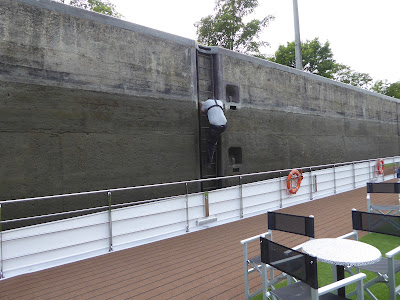















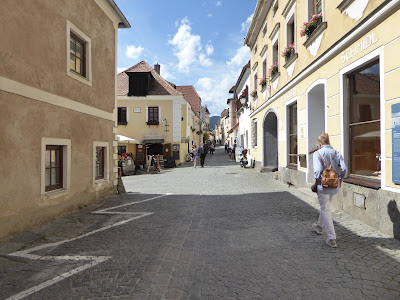







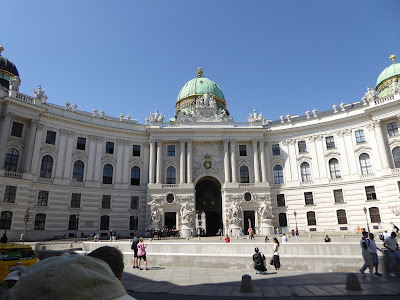




























































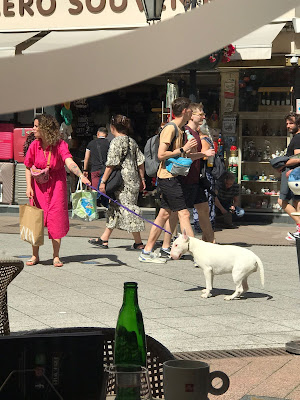


















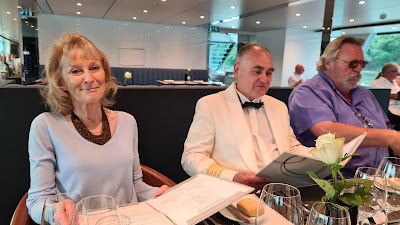



























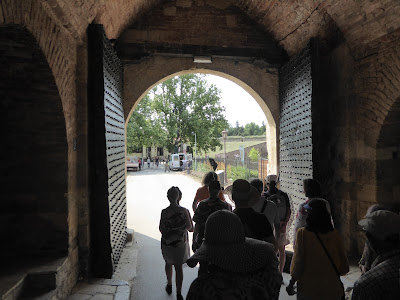







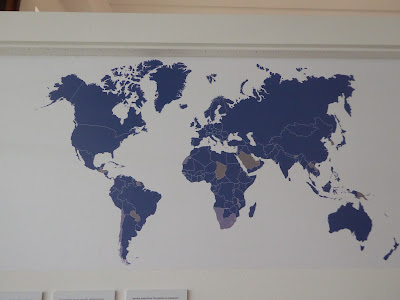













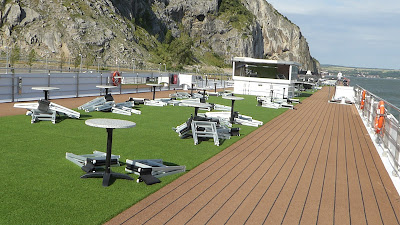























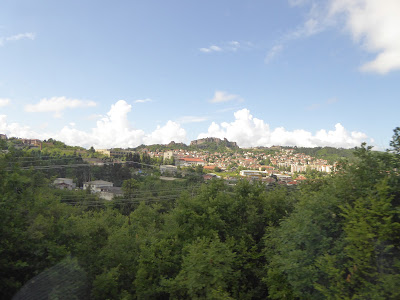





























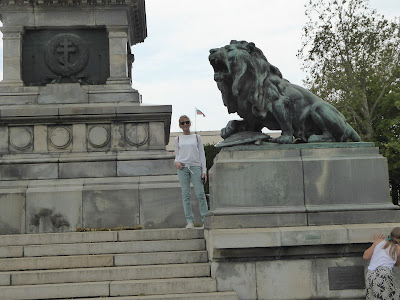















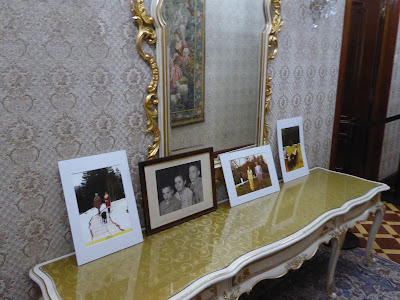




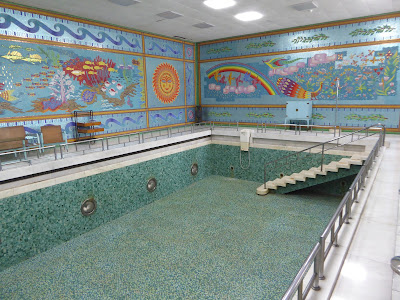




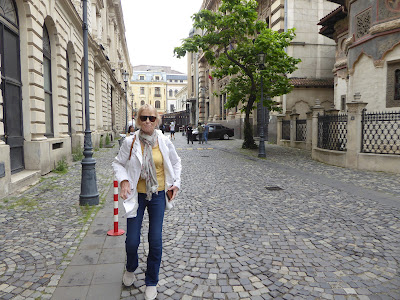




No comments:
Post a Comment